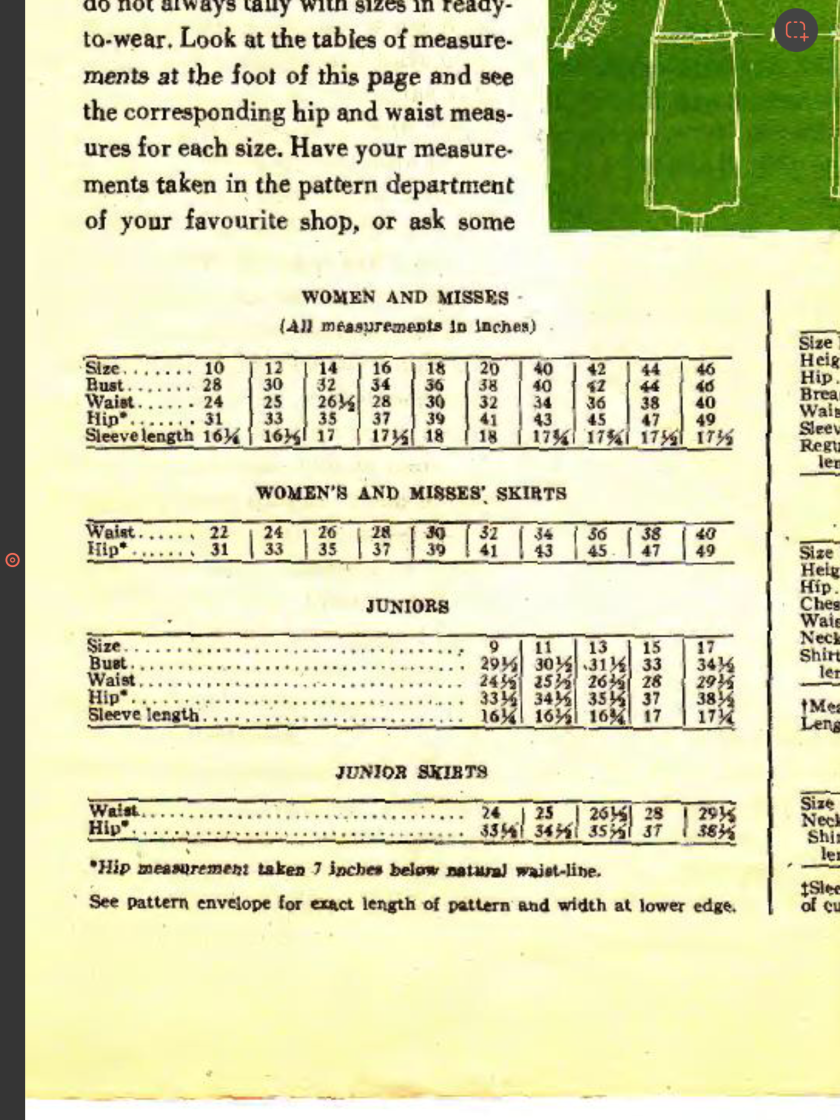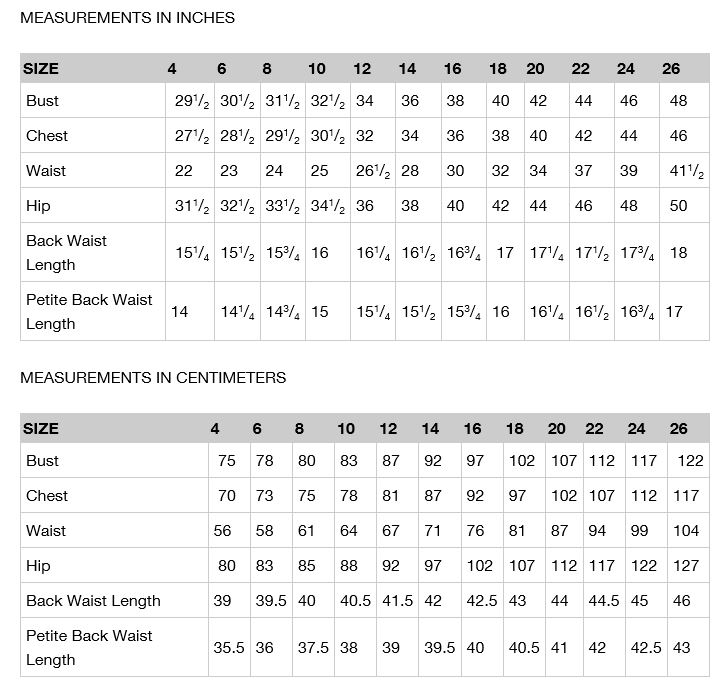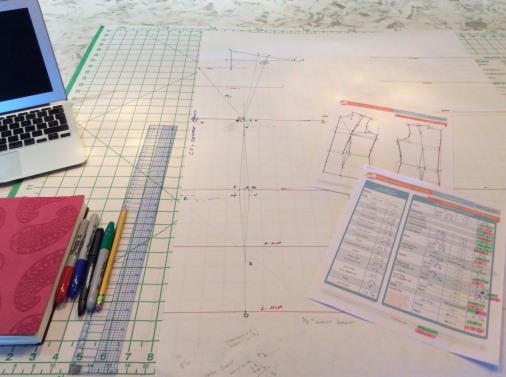 It never fails: tune into a discussion of garment pattern sizes among newbie sewers and be prepared for the lamenting to begin. Yes, you, the experienced garment producer, think to yourself, a size 8 pattern is most assuredly not going to fit you if you wear a size 8 in ready-to-wear. In fact, I understand the depths of your indignance. If you wear a size 8 in most ready-to-wear, you probably wear a size 6 in Not Your Daughter’s Jeans (yes, I’m old enough to truly appreciate them). And, to add insult to injury, you probably wear a size 0 – yes, zero – in Chicos (of course their sizing is a thing onto itself). But here’s the thing – you only wear a size 8 in North America anyway. Rest assured, you’re never going to be able to zip up that size 8 dress off the rack at Harrod’s or, god forbid that you even try, at Galleries LaFayette in Paris. That’s because a size 8 in North America ready-to wear equates to a size 12 in the UK, and generally a European size 42, just maybe a 40 (not a 38 as you might wish). So, where does that leave you in pattern sizing? Probably a size 14.
It never fails: tune into a discussion of garment pattern sizes among newbie sewers and be prepared for the lamenting to begin. Yes, you, the experienced garment producer, think to yourself, a size 8 pattern is most assuredly not going to fit you if you wear a size 8 in ready-to-wear. In fact, I understand the depths of your indignance. If you wear a size 8 in most ready-to-wear, you probably wear a size 6 in Not Your Daughter’s Jeans (yes, I’m old enough to truly appreciate them). And, to add insult to injury, you probably wear a size 0 – yes, zero – in Chicos (of course their sizing is a thing onto itself). But here’s the thing – you only wear a size 8 in North America anyway. Rest assured, you’re never going to be able to zip up that size 8 dress off the rack at Harrod’s or, god forbid that you even try, at Galleries LaFayette in Paris. That’s because a size 8 in North America ready-to wear equates to a size 12 in the UK, and generally a European size 42, just maybe a 40 (not a 38 as you might wish). So, where does that leave you in pattern sizing? Probably a size 14.

I have one thing to say to you – the same thing I had to say to myself – get over it. If you really want to be able to get your clothing to fit, ignore the number and go with what works. Let’s back-track for a moment to see if we can understand this.
Did you know that clothing sizes were invented only in the early 1800’s? Before that, there was no need of them. If you were well-to-do enough, your tailor simply made your clothes to measure – all of them. If you were less financially fortunate, you made your own, fitting them to your body, your children’s bodies and the bodies of anyone else who relied on you (the matriarch usually) to provide them with wardrobe.
According to a very interesting article in Time magazine titled, “The Bizarre History of Women’s Clothing Sizes” (which is worth a read), true sizing as we recognize it today, really began to develop in the 1940’s. Before that, children’s’ clothing, for example, was sized according to age range. Even today you usually buy baby clothes by age: 6-12 months, 18 months etc., as if every child at 12 months weighs the same!
Interestingly, the standard sizing in the US was developed through an extensive survey of some 15,000 women who volunteered to be measured. The fact that they were paid to do this also resulted in the sizing being skewed toward the sizes of those in the lower socio-economic strata of society.
As the authors of the Time article state,
“As American girth increased, so did egos…And thus began the practice of vanity sizing. Over the decades, government size guidelines were heeded less and less, items of clothing began getting marked with lower numbers and eventually, in 1983, the Department of Commerce withdrew its commercial women’s clothing size standard altogether.”
Oh vanity sizing! I remember being in a dressing room in the Gap several years ago. I was well aware that the Gap had changed their sizing, especially since I was comfortable in their size 6 jeans. Next door to me were several young women also trying on jeans. Suddenly I heard a screech: “OMG! I’ve lost weight! The size 10 fits!” Sorry, kid. You’ll really have to measure yourself and/or get on the scales to find that out if that’s true. Which is where we begin the search for the perfect fit in sewing patterns. Measuring.
There really is a knack to this measuring stuff. And then if you’re using an off-the-shelf pattern which many (most?) home sewers do, there’s the matter of finding out that you don’t really fit perfectly into any of their sizes. And it’s worth noting that in the sewing world, the notion of vanity sizing hasn’t really taken hold to the same extent, but there is no doubt about it, it’s there.
I stumbled upon this sizing chart from a 1948 Vogue sewing manual…

So, what size would you have worn in 1948? And here’s their chart today…

And not really fitting any of them perfectly? So goes the world. My answer was to seek out a way to make a personal moulage, from which I’ll create a personal block, or sloper – terms that I hadn’t even heard of six months ago.
So, I’ve embarked on a new course to learn to draft my own perfectly fitted patterns. It all begins with perfect measuring, and thankfully, I have a wonderful husband whose perfectionism borders on the mystical – a terrific trait in your measuring partner. I began there, then proceeded to the session on beginning to draft. I’ll let you know how it goes!

Time Article cited: http://time.com/3532014/women-clothing-sizes-history/



Wonderful post! Is that the Craftsy course by Suzy Furrer you are working on? I use her system and have never failed to come up with a perfectly fitting moulage/sloper for any body shape or size. The hardest part is getting accurate measurements to start with. When clients ask me what size they are: there are no sizes in custom. Your pattern is drafted to fit you and doesn’t correspond to any standard size. I do use a different system for sleeves. Enjoy your course.
LikeLike
Thank-you for your kind words on the post. Yes, I am taking Suzy Furrer’s wonderful course n the bodice sloper from Craftsy. I’ve always known that measurements were important, but now it’s always front of mind. I’ll eventually get to sleeves! In the meantime, I’m getting down to the finished the pattern for the first moulage. When I get that right, my plan is to use it also to create my custom fitting mannequin. Wish me luck – I think I’m going to need it!
LikeLike
I did exactly that: used the moulage to create a custom molded dress form. It’s such a wonderful fitting tool. I detailed my method in my April 2014 post. Hope your results are as helpful as mine were.
LikeLiked by 1 person
It was your blog post the inspired me! I never did say thank-you…so thanks! I’ll let you know how it all goes.
LikeLike
How interesting. I too signed up for Suzy Furrer’s courses, although I haven’t taken them yet (too busy sewing dresses for Granddaughters!). I was inspired to do so many months ago after reading Mary’s blog posts about her moulage. I am looking forward to following your progress.
Following my time-wasting exercise of making a duct tape dress form (that was immediately too big!), I am now wanting to buy one – a good one. Again, I listened carefully to what Mary had to say on the subject – especially about getting one that matches your shoulder size.
Do you know of a Canadian supplier/distributor of a good quality dress form Gloria?
LikeLiked by 1 person
Hi Joanna…I bought “Gloria Junior” (my mannequin) from Amazon.ca. It’s a “Dritz My Double” dress form. It’s adjustable, but therein lies the problem. Her underbust is so much wider than I am when I open her up to my bust size. That’s why I’m going to use my moulage to make a custom form with her as the base. I’ll have to make sure that she’s dialled down to her smallest in any area that might cause problems in others before I start. If you buy one, you need to be aware that she’s not the most stable one around, but she can be taken off her base and stored very easily — a boon for those of us who have downsized into a condo. It’s a big condo, but nevertheless, I don’t have four spare rooms any longer! Anyway, here’s a link to the one I bought — and go down rather than up if you’re on the edge. https://goo.gl/9niYJs
LikeLike
Prior to signing up for Suzy’s courses, I happened across the following video about taking measurements. It may be of interest: https://www.youtube.com/watch?v=SrkFchHsy2Y
LikeLiked by 1 person
Thanks for this Joanna .Very interesting. Her approach is different in some respects than Suzy’s for sure! I was wondering about the shoulder measurement. It seems to take in a much longer distance than on other measuring guides. I wonder how she uses it. I always dl like to see how others do things! Wish me luck with the custom dress form! ~GG
LikeLike
I think we are on the same quest. I’ve spent the last 7 days drafting and sewing up my moulage–number 11, I call it. I had started last year, and then hit a wall. Luckily, I still had the previous moulage and the advice Suzy had given me, but no back pattern piece. So, I redrafted, and reminded myself of how much character I was building. Anyway, I have sloper #3 approved, and I’m going to draft the shell from her new class, just to see some wearable progress. I’m sure you will do much better. I do realize that all the sewing I’ve done this year has helped me immensely, but I too, want a better fit, custom made for me. I find Suzy Furrer an excellent instructor, and her feedback is so encouraging. I find she says everything 3 times, in different ways to reiterate her points. She has answered all my posts within 24 hours. I must say, I’m very tired, but very pleased with having a sloper that is workable. I still notice that I need some truing, but I think that is an ongoing process. (My moulage is the jester green one in the Fitting lesson.)
LikeLiked by 1 person
Yes, we do seem to be on the same quest! But 11 moulages! I hope I have it in me to get there! I’m just cutting out the first moulage to sew it up. I’ll do a post in a week or two about my progress — or lack thereof. This quest for the perfect, personalized size, though, is a worthwhile one in my view. I think fit is of the essence in fashion & style for any age — but especially when you’re “of a certain age” as I am! And yes, I agree: Suzy is wonderful. Wish me luck… ~GG
PS I’ll look for ‘jester green.’ I read all the questions and her answers
LikeLike